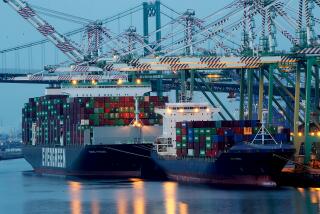Union Pacific Works to End Delays, but No Date Is Given
Union Pacific Corp., trying to defuse criticism over its worst shipping delays in six years, told customers that it was adding workers and locomotives, without saying when cargo congestion might end.
“All of us are acutely aware that we have failed to meet our customers’ needs,” Chief Executive Richard Davidson said at a meeting Monday in San Francisco to hear customer complaints. “I’ve resisted the urge to forecast a specific date as to when everything will be fine.”
The logjams have been particularly acute in Southern California, where about one-quarter of Union Pacific’s freight either originates or ends up. The problems emerged during the slow season for the region’s enormous ports in Los Angeles and Long Beach. So far, they haven’t seriously affected retailers’ inventories or shortchanged consumers, analysts said.
Still, a number of companies that rely on the rail system to transport their products are feeling the effects.
“We’ve already factored in a two-day delay in moving our shipments out of West Coast ports, and I expect that will go up by another day” late this year, said Larry Rupp, shipping manager for computer maker Hewlett-Packard Co.
The Palo Alto company is moving some rail-bound shipments by truck. “That’s more expensive,” Rupp said, “but we don’t have much choice.”
The meeting with railroad executives gave customers a chance to “hear what the railroad is doing to improve” operations, though the slowdown probably will persist for the rest of 2004 given the time needed to add staff, said Rupp, who attended the meeting.
Shares of Omaha-based Union Pacific, the nation’s largest railroad, fell 16 cents to $56.30 on the New York Stock Exchange.
The railroad blames the delays and congestion on a shortage of train-crew workers. Union Pacific is adding as many as 4,200 workers and acquiring more than 600 locomotives.
Customers are frustrated by the lack of guidance on when service will improve, Morgan Stanley analyst James Valentine told investors, because “it impacts their ability to plan for the peak shipping season this fall.”
By summer, the volume of cargo coming into Southern California ports will surge 30% or more as Asian goods arrive for the back-to-school and holiday seasons, and some observers fear that the increase will overwhelm Union Pacific and disrupt the economy if the bottlenecks aren’t fixed.
More to Read
Inside the business of entertainment
The Wide Shot brings you news, analysis and insights on everything from streaming wars to production — and what it all means for the future.
You may occasionally receive promotional content from the Los Angeles Times.










